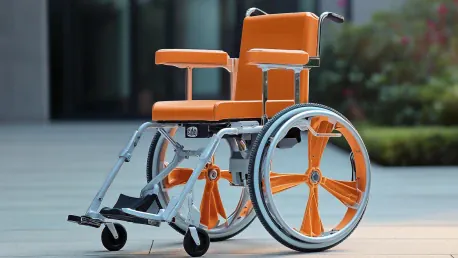The development of CoNav, a smart robotic wheelchair, marks a significant advancement in assistive technology for individuals with motor impairments. Developed by researchers at the University of Michigan, CoNav combines user input with autonomous navigation to enhance mobility and independence. This innovative wheelchair addresses the limitations of existing models, offering a more natural, efficient, and user-friendly experience. With the integration of cutting-edge technology and a focus on user-centered design, CoNav revolutionizes the approach to mobility aids, making it easier for individuals with disabilities to navigate their environments with confidence and ease.
Motivation Behind CoNav’s Development
The motivation for developing CoNav stems from the challenges faced by individuals with disabilities in achieving independent mobility. Traditional wheelchairs are either fully autonomous or manually controlled, each with its own set of limitations. Fully autonomous wheelchairs often struggle in dynamic environments, while manually controlled ones can be difficult for individuals with severe mobility impairments. CoNav aims to bridge this gap by providing a blend of autonomy and user control. Researchers at the University of Michigan recognized the need for a solution that could offer both independence and ease of use. By integrating advanced technologies, they sought to create a wheelchair that could navigate complex environments while allowing users to maintain a sense of control. This led to the development of CoNav, a wheelchair that leverages shared control to enhance the user experience.
The researchers observed that existing wheelchair models either lacked the necessary intelligence to adapt to changing surroundings or required significant physical effort from the user. This dual challenge motivated them to pursue a hybrid approach, where the system would be capable of autonomous decision-making while still valuing the user’s input. Through extensive research and testing, the team identified the key components and algorithms necessary to achieve this balance. The result is CoNav, a wheelchair that not only meets the mobility needs of users but also adapts to their varying levels of physical capability, providing a more inclusive solution for a diverse user population.
Technical Innovations in CoNav
CoNav is built using a Robot Operating System (ROS) based framework, which merges user input with autonomous navigation through model predictive control (MPC). This intelligent decision-making method allows the wheelchair to offer shared control, enabling users to exert partial control over the chair’s movements while the system autonomously navigates based on environmental data. The technical innovation behind CoNav lies in its ability to seamlessly integrate user commands with AI-driven navigation, ensuring that the wheelchair can respond accurately and quickly to both planned and unexpected changes in the environment.
The wheelchair is equipped with various components, including a joystick for user input and sensors such as LiDAR, cameras, and an IMU for environmental mapping. Users indicate their desired direction using the joystick, while the sensors detect obstacles, walls, and pathways. This data is used to generate an optimal path to the destination, allowing the chair to respond to user input when available and switch to autonomous navigation when input ceases. The sophisticated sensor suite collects real-time data, which is processed by the onboard computer to create a detailed map of the surroundings. This map is then used to make informed decisions about the safest and most efficient route to the user’s destination.
The ROS-based framework and MPC algorithm enable CoNav to dynamically adjust its path based on changing conditions, such as moving obstacles or shifts in the user’s direction. The intelligent decision-making process ensures that the wheelchair can navigate complex environments with precision, reducing the risk of collisions and enhancing the overall safety of the user. Additionally, the modular design of CoNav’s system architecture allows for future upgrades and enhancements, ensuring that the wheelchair can continue to evolve with advancements in technology.
Enhancing User Experience
The integration of shared control in CoNav significantly enhances user effort reduction, collision prevention, and overall experience improvement. By preventing constant manual corrections and intelligently avoiding obstacles, CoNav ensures smoother and more intuitive navigation. This approach boosts user trust as it balances autonomy with user input, fostering greater accessibility and usability. Users of CoNav benefit from a more comfortable and natural navigation experience, with the adaptive control system allowing the wheelchair to respond dynamically to their input while leveraging the chair’s autonomous capabilities.
The adaptive control system provides a sense of control, allowing users to feel empowered and engaged in their own mobility. Unlike traditional wheelchairs that require constant physical effort and vigilance, CoNav reduces the cognitive and physical burden on users by managing many of the complexities involved in navigation. This results in a more efficient and enjoyable journey, as the wheelchair can handle difficult tasks while the user can focus on their surroundings or other activities. The combination of shared control and intelligent navigation creates a more harmonious interaction between the user and the wheelchair, promoting greater independence and quality of life.
Furthermore, the user-centered design of CoNav ensures that the wheelchair is adaptable to a wide range of needs and preferences. Customizable settings and modes allow users to tailor the level of autonomy and control to their comfort level, ensuring that they receive the support they need without feeling overwhelmed or restricted. This flexibility makes CoNav suitable for various environments and scenarios, from crowded public spaces to more controlled and familiar settings, providing users with the confidence to explore and engage with the world around them.
Advantages Over Traditional Wheelchairs
Compared to fully autonomous or manual wheelchairs, CoNav performs better in complex and dynamic environments. The shared control system reduces abrupt movements, avoids collisions, and provides a natural and comfortable user experience. Users can reach their destinations faster and with more comfort, feeling in control of the movement while benefiting from the chair’s autonomous capabilities. The ability to navigate efficiently and safely in various environments makes CoNav a superior choice for individuals with disabilities. The wheelchair’s intelligent navigation system ensures that users can move through crowded or obstacle-filled spaces with ease, enhancing their overall mobility and independence.
Traditional wheelchairs often require users to exert significant physical effort to navigate through challenging environments, leading to fatigue and discomfort. Fully autonomous wheelchairs, while reducing physical strain, may struggle to make quick decisions in dynamic settings, potentially compromising safety. CoNav strikes a balance between these two extremes by combining the best aspects of both autonomy and user input. This hybrid approach minimizes user effort while maximizing safety and efficiency, making it an ideal solution for those with severe motor impairments who need reliable and adaptive mobility support.
In addition to its superior navigation capabilities, CoNav’s design also emphasizes user comfort and ease of use. The ergonomic layout of the controls, along with the responsive joystick and intuitive sensor interface, ensures that users can interact with the wheelchair seamlessly. The system continuously learns and adapts to the user’s behavior, further enhancing the tailored experience. By addressing the limitations of existing wheelchairs and providing a more holistic solution, CoNav represents a significant leap forward in assistive technology, offering individuals with disabilities a new level of freedom and independence.
Real-World Testing and Performance
CoNav was evaluated through real-world experiments in indoor environments featuring static and moving obstacles. The results indicated superior performance in efficiency, safety, and user satisfaction compared to traditional wheelchair models. Fewer collisions and more successful navigation were observed, showcasing the practicality and benefit of the shared control approach. These real-world tests demonstrated that CoNav could effectively navigate complex environments, providing users with a reliable and safe mobility solution. The positive feedback from users highlights the potential of CoNav to transform the lives of individuals with motor impairments, offering them greater independence and confidence in their daily activities.
The testing process involved a diverse group of users, each with varying levels of mobility impairment, to ensure that CoNav’s performance was robust across different scenarios. Through rigorous trials in settings that mimicked real-world conditions, the researchers were able to refine the wheelchair’s algorithms and hardware, addressing any issues that arose. The data collected from these experiments provided valuable insights into how CoNav could be further improved, leading to enhancements in the control systems and sensor integration. The overwhelmingly positive results from these tests underscored the effectiveness of the shared control approach and the potential for broader application in the field of assistive technology.
Moreover, the real-world testing phase offered an opportunity to gather user feedback and assess the overall user experience. Participants reported feeling more confident and secure while using CoNav, as the intelligent navigation and collision avoidance features allowed them to maneuver through challenging environments with ease. The reduction in physical effort and cognitive load was particularly noted, with users appreciating the balance between autonomous support and the ability to maintain control. These findings suggest that CoNav has the potential to greatly enhance the quality of life for individuals with disabilities, enabling them to participate more fully in various aspects of daily life.
Potential Applications and Future Improvements
The development of CoNav represents a major milestone in assistive technology for people with motor impairments. Engineered by researchers at the University of Michigan, CoNav is a smart robotic wheelchair that synergizes user input with autonomous navigation. This powerful blend of technology significantly enhances mobility and boosts independence for its users. Traditional wheelchairs often come with a host of limitations, but CoNav tackles these, offering a more intuitive, efficient, and user-friendly alternative.
CoNav’s design is particularly noteworthy for its focus on user-centered functionality. This innovation allows individuals with disabilities to navigate their surroundings with newfound confidence and ease. The wheelchair combines cutting-edge technology, such as sensors and software algorithms, to create a seamless experience. This intelligent system can map out routes, avoid obstacles, and understand user preferences, making movement smoother and more predictable.
By integrating such advanced technology, CoNav revolutionizes the landscape of mobility aids. It does more than just transport; it empowers users by offering them greater control and freedom. The implications of this are profound, opening up new possibilities for personal independence and quality of life for individuals with motor impairments. With CoNav, navigating the environment becomes not just easier but also a more enjoyable experience.









